
The Legion of Merit (LOM) is a military award of the United States Armed Forces that is given for exceptionally meritorious conduct in the performance of outstanding services and achievements. The decoration is issued to members of the eight uniformed services of the United States as well as to military and political figures of foreign governments.
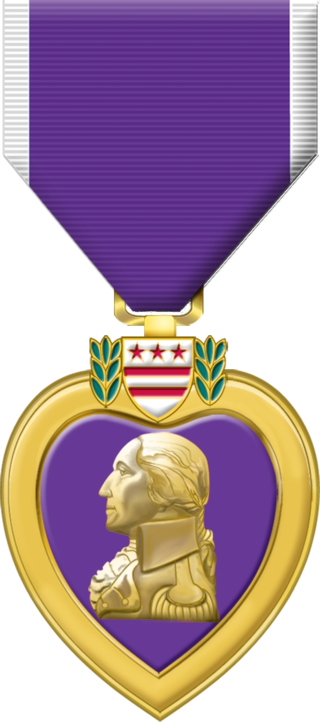
The Purple Heart (PH) is a United States military decoration awarded in the name of the president to those wounded or killed while serving, on or after 5 April 1917, with the U.S. military. With its forerunner, the Badge of Military Merit, which took the form of a heart made of purple cloth, the Purple Heart is the oldest military award still given to U.S. military members. The National Purple Heart Hall of Honor is located in New Windsor, New York.

The Navy Cross is the United States Naval Service's second-highest military decoration awarded for sailors and marines who distinguish themselves for extraordinary heroism in combat with an armed enemy force. The medal is equivalent to the Army's Distinguished Service Cross, the Air and Space Forces' Air Force Cross, and the Coast Guard Cross.

The Republic of Vietnam Gallantry Cross also known as the Vietnamese Gallantry Cross or Vietnam Cross of Gallantry is a military decoration of the former Government of South Vietnam. The medal was created on August 15, 1950, and was awarded to military personnel, civilians, and Armed Forces units and organizations in recognition of deeds of valor or heroic conduct while in combat with the enemy.

Various medals, service ribbons, ribbon devices, and specific badges recognize military service and personal accomplishments of members of the U.S. Armed Forces. Such awards are a means to outwardly display the highlights of a service member's career.
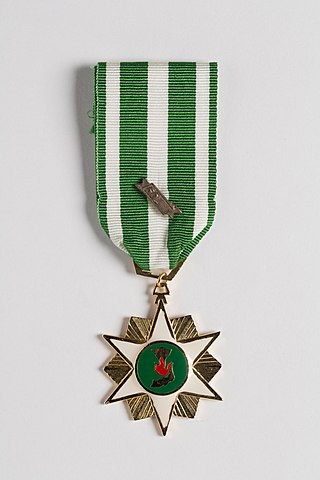
The Republic of Vietnam Campaign Medal, also known as the Vietnam Campaign Medal, is a South Vietnamese military campaign medal which was created in 1949 and awarded during the First Indochina War. During the Vietnam War, the South Vietnamese government awarded the Republic of Vietnam Campaign Medal with Device to members of the South Vietnamese military for wartime service and on March 24, 1966, to members of the U.S. military for support of operations in Vietnam. In May 1966, other allied foreign military personnel became eligible for the award.
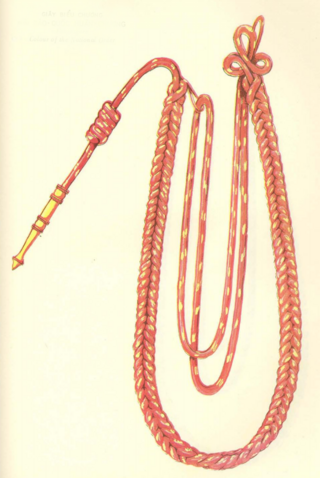
The National Order of Vietnam was a combined military-civilian decoration of South Vietnam and was considered the highest honor that could be bestowed upon an individual by the Republic of Vietnam government.

The Military Merit Medal was the highest military decoration bestowed to enlisted personnel by the Republic of Vietnam during the years of the Vietnam War. The medal was established on August 15, 1950. The Military Merit Medal was modeled after the French Médaille Militaire and was awarded mostly to enlisted men for valor in combat. The medal had three different versions, coincided with the political change in South Vietnam: the State of Vietnam, the First Republic, and the Second Republic version. The Vietnamese National Order of Vietnam was considered the equivalent decoration for military officers.
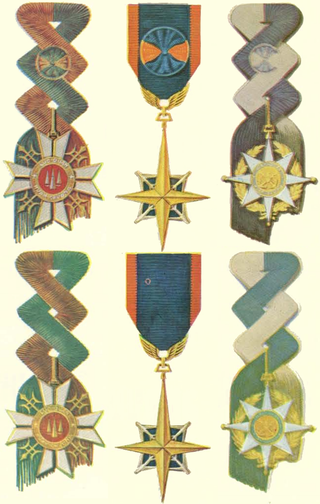
The Army Distinguished Service Order, Air Force Distinguished Service Order, and Navy Distinguished Service Order was a military decoration of South Vietnam which was awarded throughout the years of the Vietnam War. The decoration was bestowed for meritorious or heroic deeds related to wartime operations and was awarded for both combat and non-combat service.

The Republic of Vietnam Civil Actions Medal also known as the Vietnam Civil Actions Medal or Civil Actions Medal, is a military decoration of the former South Vietnamese government (1955–75). The medal was created on May 12, 1964 during the Vietnam War. The Civil Actions Medal was awarded to the South Vietnamese military and its allies' military personnel or units that performed outstanding achievements in the field of civil affairs. The medal was awarded in two classes, with the first-class intended for commissioned officers and the second class for enlisted personnel. Individuals who were cited received the medal, ribbon, and a citation.

The Republic of Vietnam Staff Service Medal was a military award of South Vietnam established in 1964. The medal was awarded in two classes and was awarded for outstanding initiative and devotion an individuals assigned staff duty.

The orders and decorations conferred upon civilians and military personnel in the Republic of the Philippines are listed by orders of precedence. Philippine civilian orders and decorations are conferred by the President of the Philippines in his or her capacity as head of state. In certain instances, the conferment of certain orders and decorations requires the concurrence of the Congress of the Philippines, or of certain advisory bodies.

The Technical Service Medal was a military award of South Vietnam established in 1964. The medal was awarded in two classes and was awarded for outstanding initiative and devotion an individuals assigned staff duty.
Authorized foreign decorations of the United States military are those military decorations which have been approved for wear by members of the United States armed forces but whose awarding authority is the government of a country other than the United States.
Awards and decorations of the Vietnam War were military decorations which were bestowed by the major warring parties that participated in the Vietnam War. North Vietnam, South Vietnam, Australia, New Zealand and the United States all issued awards and decorations to their personnel during, or after, the conflict.

The Kuwait Liberation Medal is a medal created in 1994 that was issued by the government of Kuwait to both local and foreign military personnel who served in the Gulf War's "Liberation of Kuwait" campaign phase of 1990 and 31 August 1993.
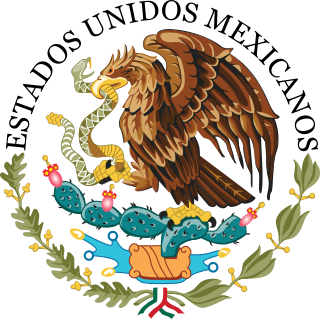
This is a list of military decorations awarded by the United Mexican States as part of the Mexican Honours System.
Colombian military decorations date back as far as the founding of the country. An early decoration was the Cruz de Boyacá that was awarded to the generals who led their forces to victory in the Battle of Boyacá in 1819. This early decoration lives on today as an incarnation of the highest order presented by the Colombian state. There is one decoration higher, but it is only awarded for military conflicts in defence of Colombia. Other than military decorations, Colombia presents decorations on behalf of the National Government, decorations for the National Police, and decorations from the Congress of Colombia.
The system of Orders, decorations, and medals of South Vietnam came into being with the establishment of the National Order of Vietnam in 1950. Established by Bảo Đại, the head of state of the State of Vietnam, the order was the highest award of the state for both civilians and military personnel. This level of precedence continued under the government of South Vietnam. Lower ranking awards for both the military and civilians were subsequently established. The systems of civilian and military awards had their own order of precedence.
The Decoration Honor of Naval Merit Commander Peter Campbell is an Uruguayan military decoration awarded by the President of Uruguay to civilians, military officers, military units or to institutions, Uruguayan or foreign, as a recognition of the relevant services or works performed to the Uruguayan Navy. This decoration was named after Peter Campbell, an Irish naval officer who became the first commander of the Naval forces created by José Artigas.















